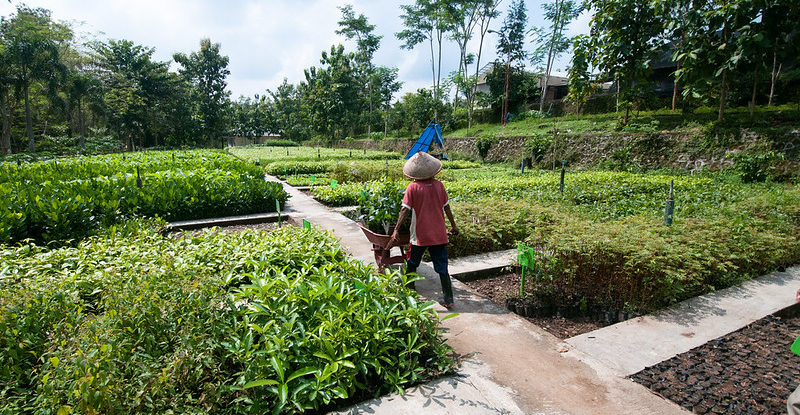
Indonesia’s positive experience with decentralized land management in recent decades highlights the importance of supportive governance in reconciling the competing interests that hinder landscape sustainability, according to a recent analysis conducted by a team of scientists.
Biodiversity, ecosystem services and human well-being in forested landscapes rely on the success of integrated landscape approaches. Practitioners must adapt their strategies to local priorities and align their land-use actions with prevailing policy.
These were among the findings of a recent study by the Center for International Forestry Research (CIFOR) and Canada’s University of British Columbia (UBC).
Integrated landscape approaches are vital to accommodate the social, environmental and political differences among stakeholders involved in land management worldwide. The strategic approach aims to bring about improvements in governance in order to support the realization of the U.N. Sustainable Development Goals.
As competition for land grows in Indonesia, such techniques for achieving sustainability should also increase, according to the study, which points out that greater civil society engagement and recognition of customary management rights and responsibilities have positively impacted the prospects for success.
Seven of the eight cases reviewed by researchers reported improvements in governance as a result of the landscape approach initiative.
Decision making that affects landscapes is rarely motivated solely by ecological considerations, but is more likely to be the product of political and market interests as well as cultural and developmental needs, according to the authors.
In Indonesia, the collaborative landscape approach – involving multiple stakeholders, actors and levels of governance – follows a long history of conservation approaches, which met with varying degrees of success. During the 1970s and 1980s, about 22 percent of the nation’s land surface was allocated to national parks and other protected zones. In the 1990s, Indonesia’s conservation focus expanded to other areas.
However, when the country decentralized its governance system starting in 1998, lower-level institutions lacked the capacity to resist special interest groups and their influence over local decision making. With competing land uses and overlapping legislation, forests were increasingly converted to oil palm, while peatland fires burned, air pollution worsened and biodiversity was lost.
“As we are seeing in Indonesia, these problems can be addressed by an integrated landscape approach that involves government, non-government and private actors at different scales,” said Ani Adiwinata, a CIFOR scientist who contributed to the study. “With stronger institutional capacity, standardized land-use mapping and the development of social forestry schemes, good governance is key to making progress toward improved conservation results.”
Through questionnaires and follow-up discussions over a three-year period, participants in the integrated landscape initiative reviewed by scientists provided insights into the strengths and challenges of such programs in landscapes ranging from peri-urban (Gunung Kidul, Java) and plantations (Kampar Peninsula, eastern Sumatra) to mosaic (Kelola Sendang, south Sumatra) and natural mountain forests (Mbeliling, East Nusa Tenggara).
One program in Gunung Kidul is part of the Kanoppi Project and involves a unique karst landscape characterized by significant biodiversity as well as an underground system of springs and aquifers. Managing this natural wonder must consider a range of stakeholders, including communities, industries and government, Adiwinata said.
All of the initiatives evaluated by the researchers identified a need to operate beyond the usual boundaries of conservation programs, and attempted to engage multiple sectoral government agencies, communities, traditional (Adat) leaders, private companies and other stakeholders. This was usually done by forming leadership bodies that reflected the diverse range of participants. Successful initiatives sought to forge a common vision and incorporate local preferences for achieving goals.
“While a shared vision can help bring stakeholders together, it is finding ways to overcome challenges and make progress that is most important – and also the most difficult,” said Rebecca Riggs, a researcher in the Faculty of Forestry at UBC who was the study’s lead author. “Stakeholders may have their own objectives that override the concerns of others. Dealing with these trade-offs is what building consensus is all about.”
There were also other challenges reported among the eight initiatives. In areas with intense competition for land – in Kapuas Hulu (West Kalimantan), Ketapang (West Kalimantan) and Kelola Sendang – there was no intermediary to guide landscape decisions. This makes environmental degradation more likely as no single government agency in Indonesia decides on land-use allocation and planning, thereby enabling powerful alliances to dictate behavior, such as illegal land clearing.
“There are two main things that influence improvements in governance – what is happening in the landscape, as well as the broader enabling conditions that exist at regional, national or international levels,” Riggs said. “Conducive policy is really important for sustaining landscape governance. This includes legislation and funding that encourage cross-sectoral collaboration.”
The lessons learned in this study may also be relevant to other countries seeking to implement integrated landscape approaches, according to Riggs. There are opportunities for businesses to play a leading role in meeting both production and conservation goals in the landscapes where they operate.
“The way that initiatives engage in international partnerships shows learning across countries is already happening,” Riggs said. “Landscape practitioners in Indonesia are contributing to the growing understanding of integrated landscape approaches globally.”
The study was partially funded by the Social Sciences and Humanities Research Council of Canada (SSHRC). The Kanoppi Project was supported by the Australian Center for International Agricultural Research (ACIAR) and was part of the CGIAR Research Program on Forests, Trees and Agroforestry, which is supported by CGIAR Fund Donors.
We want you to share Forests News content, which is licensed under Creative Commons Attribution-NonCommercial-ShareAlike 4.0 International (CC BY-NC-SA 4.0). This means you are free to redistribute our material for non-commercial purposes. All we ask is that you give Forests News appropriate credit and link to the original Forests News content, indicate if changes were made, and distribute your contributions under the same Creative Commons license. You must notify Forests News if you repost, reprint or reuse our materials by contacting forestsnews@cifor-icraf.org.